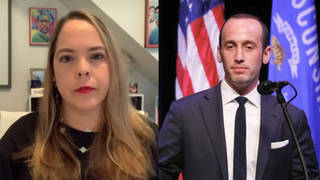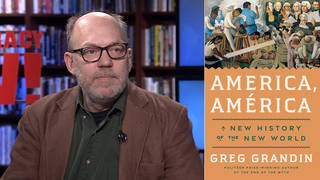
The Trump administration has once again slashed the number of refugees allowed to resettle in the United States. On Monday, Secretary of State Mike Pompeo announced the new cap on refugees would be a historic low of just 30,000 next year, down from the current level of 45,000. The actual number of refugees allowed in to the country is expected to be even lower than the 30,000 cap. Monday’s announcement represents the lowest ceiling any president has imposed on the U.S. refugee program since its creation in 1980. Under President Obama, the refugee cap reached 110,000. For more on the Trump administration’s refugee policy, we speak with Ryan Mace, refugee specialist for Amnesty International USA.
Transcript
AMY GOODMAN: This is Democracy Now! I’m Amy Goodman, with Juan González.
JUAN GONZÁLEZ: Well, the Trump administration has once again slashed the number of refugees allowed to resettle in the United States. On Monday, Secretary of State Mike Pompeo announced the new cap on refugees would be historically low, of just 30,000 next year, down from the current level of 45,000.
SECRETARY OF STATE MIKE POMPEO: The improved refugee policy of this administration serves the national interest of the United States and expands our ability to help those in need all around the world. We will continue to assist the world’s most vulnerable while never losing sight of our first duty—serving the American people. We are and continue to be the most generous nation in the world.
JUAN GONZÁLEZ: The actual number of refugees allowed in to the country is expected to be even lower than the 30,000 cap. Monday’s announcement represents the lowest ceiling any president has imposed on the U.S. refugee program since its creation in 1980. Under President Obama, the refugee cap reached 110,000.
AMY GOODMAN: Well, for more on the Trump administration’s refugee policy, we go to Washington, D.C., to speak with Ryan Mace, refugee specialist for Amnesty International USA.
Ryan, thanks for joining us. Talk about the significance of this number and what it means for refugees around the world.
RYAN MACE: Yes, thank you so much for having us on. It’s an honor to be on. Yeah, this really is quite significant, the announcement that the secretary made on Monday. It really is. We’re calling it an abandonment of our commitment to this vital protection. The U.S. Refugee Admissions Program is a program that was started in the 1980 Refugee Act. It’s a bipartisan program. It’s a program that we should all be very proud of. Over 3 million refugees have been resettled through this program since 1980. And as you said, presidents, from Ronald Reagan, George Bush, President Obama, had set the refugee admissions goal at the start of every fiscal year. And it’s a goal that both shows our commitment to this vital protection, it shows our commitment as the United States, and it really does show the world that we are committed to this program.
So, as you said, in the last full year of the Obama administration, in fiscal year 2016, they set the goal at 85,000. At the time, that actually was quite a high goal to set. Previously, the goal had been around 70,000. So, they—and as you might recall, this was during the time—we’re still in this time, but where Syrian refugees were obviously really on the front page of the news. There was a lot of political pressure for the United States and other countries to do more. And President Obama and the administration realized that. They set a goal that was definitely a higher goal than there had been. But the political will was there to say, “We are going to do this.” And that meant that they had to—to do the work to achieve that goal, we had to send people to do interviews on the ground, those security interviews that are so important. And we achieved that goal. It was 85,000, just a little under that, but they did meet that goal.
And that’s really the difference between previous administrations and the current one that we’re in, is that previous administrations set that goal at the start of the fiscal year in consultation with Congress and the American people. And they set that goal, and then they worked to achieve it throughout the year. And the difference is that at the start of this fiscal year, the one that we’re in, the Trump administration set a goal of 45,000. At the time, that was the worst goal that the—the lowest goal that any administration had ever set. And unfortunately, there has been really no effort to try and reach even half of that goal. We’re a few short weeks away from the end of this fiscal year. And I just looked it up before I came in. We’re about 21,000—at 21,000 refugees through the course of this last year who have been able to be resettled here in the U.S. And again, that’s half—half—of the goal that we set.
And that is so unfortunate. That leaves behind families who are seeking to be reunited with relatives here in the U.S. It leaves behind people who urgently need medical attention. It leaves behind people who are at real risk of their life or their well-being in the countries in which they’re in. So—
JUAN GONZÁLEZ: And, Ryan—Ryan, if I can ask you—
RYAN MACE: Of course.
JUAN GONZÁLEZ: In terms of the admissions and resettlement, could you talk about what countries the large bulk of the refugees are coming from now, let’s say, during the Trump administration? Has there been any change from under the Obama administration in terms of the countries from which people are coming?
RYAN MACE: Yeah, of course. I mean, if you look at the difference in the past few years, you really can see, of course, every country has gone down, unfortunately, simply because, of course, the goal has lowered so significantly in the past two years of this Trump administration. You’re also seeing that, again, there’s only a few countries where you’re really seeing over a couple of thousand refugees even coming. Most countries in this fiscal year are in the hundreds, because, again, we’re talking about such a low number compared to previous fiscal years.
I think one of the most stark numbers is, of course, for Syrian refugees. The Syrian refugee crisis, of course, everyone knows it’s one of the worst refugee crises that we’ve faced. There’s millions of refugees who have been forced to flee Syria, usually to the surrounding region. Jordan, Lebanon, other countries really do host a significant amount. It will be shocking, but the United States this year has only accepted 60—six-zero—Syrian refugees this year. A shocking number. Last year, there was around 6,000 that were resettled, and primarily, probably, in the first few months of the fiscal year, when Obama was still the president. And the last full year of President Obama’s administration, there were almost 12,000 Syrians who were resettled here in the U.S.
JUAN GONZÁLEZ: And could you clarify the difference between the refugees admitted and asylum seekers?
RYAN MACE: Yeah, that’s a really important question and distinction. So, refugees, especially when you view it in the U.S. context, but refugees are people who come in the U.S. through the U.S. Refugee Admissions Program. So, they’re people who have fled their country of origin because of fear of persecution based on who they are or what they believe, and then they go through the U.S. Refugee Admissions Program. Usually they’re referred by the United Nations. They’ve gone through the United Nations’ own vetting and biometric process. And then, once the U.N. refers them to the U.S. for resettlement because the U.N. believes that they would be well placed in the U.S. because of either a family connection, a U.S. tie, or because we have, of course, the ability to accept them—the U.S. has historically received the largest amount—they go through the U.S. Refugee Admissions Program.
Asylees are people—again, in a U.S. context, are people who come to our border, or, you know, maybe they came on some—through some other means, a student visa, and then they realize that while they’re here, that they fear going back. Maybe there’s a war that breaks out in their country, or maybe they get threats against their life or they had threats against their life.
AMY GOODMAN: Ryan, we have to wrap up, but we just want to ask—
RYAN MACE: Of course.
AMY GOODMAN: Do you believe people will die if this cap is enforced?
RYAN MACE: Yes. Unfortunately, this is very much a matter of life and death. These are people who are—again, they’re all over the world. And there’s people who urgently need access to this durable protection.
AMY GOODMAN: The Trump administration received so much backlash to Pompeo’s announcement that the State Department said they’re just bringing this proposal to Congress, it hasn’t been fully decided yet. So we will continue to follow this issue. Ryan Mace, refugee specialist for Amnesty International USA, thanks so much for joining us.













Media Options